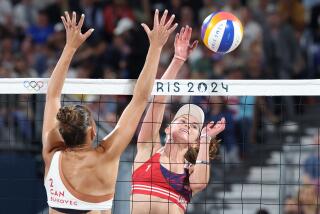Dunphy Helps to Restore Luster to U.S. Volleyball
- Share via
Coach a men’s volleyball team to an Olympic gold medal?
Marv Dunphy had been there, won that. He did his tour of duty in 1988, in Seoul, South Korea, served his country well and came home decorated. His mission was accomplished, his old job at Pepperdine University awaited him, it was time to reclaim the collegiate routine and leave the five-ring circus to someone else.
So when current U.S. men’s volleyball Coach Doug Beal came to him 11 years later, saying he was looking for an assistant for the Sydney 2000 campaign, Dunphy gave him the names of every other potential candidate across the map.
“We chatted and we chatted and we chatted, went through former players and coaches,” Dunphy says. “And then I went home and my daughter, who was 13, said, ‘Dad, where have you been?’
“ ‘I told you I was going to dinner with Doug.’ “She says, ‘Yeah, but that was four or five hours ago.’
“Then I told her what the topic of discussion was, and she said, ‘Dad, why don’t you help him?’ ”
At that point Dunphy hemmed and hawed and muttered something about having done that all before, a long, long time ago.
Alexandra Dunphy looked at her father and said, “Yeah, Dad, but I was only 2 years old. I don’t remember winning the gold medal.”
In Olympic volleyball parlance, that is known as a deal maker.
“For me, that was the start,” Dunphy says with a smile. “I wouldn’t have gone any further unless she had said that. I looked at my wife and they were both open to it. We rented our house, and headed up to [USOC headquarters in] Colorado Springs.”
In May 1999, Dunphy reenlisted with the U.S. men’s volleyball program, adding his gold-medal experience to that of Beal, who guided the American men to their first Olympic championship at Los Angeles in 1984. Two men, two gold medals, united in their ambition for one more.
It looks good in black and white. But the reality of the situation, as Dunphy understates it, is that he and Beal were facing “a little bit of a challenge.”
Such as resurrecting a program that embarrassed itself in Atlanta in 1996--the host Americans finished ninth among 12 teams, ahead of only Poland, South Korea and Tunisia--and seeing that it qualifies for the next round in Sydney.
Team USA failed in its first attempt to qualify, finishing tied for second with Cuba and Italy at the 1999 World Cup but losing out on set differential. The Americans got a second chance in January, at the Continental Cup in Winnipeg, and got it done there--earning a berth in the Sydney Olympic field by sweeping past Puerto Rico, Mexico and Canada.
With its triumph in Winnipeg, the United States climbed back to No. 5 in the FIVB world rankings. And with victories over No. 1 Italy, No. 3 Cuba, No. 4 Brazil and Yugoslavia during the last eight months, Team USA has reestablished itself as an Olympic medal contender.
BLOCKING OUT THE MEMORY OF ’96
Dunphy attended the 1996 Olympics as an advisor to the U.S. team, assigned to scout opponents. He treads diplomatically around the topic when asked about the collapse of the Americans.
“I don’t know if it was something that went wrong,” he says. “The rest of the world kind of caught up with us. We won the ’84 gold, ’88 gold, the bronze in ’92. And it wasn’t that we got any worse--it’s just that men’s volleyball got a lot better.
“At that time, and it’s an ongoing struggle, we just didn’t have the talent pool in men’s volleyball [that the United States once had]. We had a good draft in the early ‘80s . . . but it’s like any draft. If you keep [those players] around long enough, then it’s going to deny access to the team for the next generation, because those veterans are there.”
If the 1996 Olympics demonstrated anything, it’s that the cast of aging veterans had run its course. Six members of the 1996 team remain in the program-- Lloy Ball, Mike Lambert, Tom Sorensen, John Hyden, Jeff Nygaard and Dan Landry--but the United States’ resurgence has been triggered by the addition of such young players as opposite hitter George Roumain, who played for Dunphy at Pepperdine, and middle blocker Ryan Millar.
“We’re just now establishing who we are,” Dunphy says. “I think we have some good firepower. We can hit the ball.”
South Korea discovered that as it endured a shelling during a five-match swing through the western United States in April, losing four of the five encounters.
Those aren’t just volleyballs the Americans are spiking, it’s the memory of ’96 as well.
“A missed opportunity,” Dunphy calls it. “At home, without a professional league in the United States--you’re not in the newspaper every day. We had a chance to shine. And it just didn’t go our way.”
Sydney, then, represents the second chance--for Team USA, for Beal, for Dunphy.
And if there’s another medal to be had, Alexandra Dunphy will be on hand to witness the presentation.
“She’ll be there,” Dunphy says with a laugh. “That was part of the deal.”
2:14 OR BUST
Confusion has reigned in the run-up to the U.S. Olympic men’s marathon trials, to be held today in Pittsburgh.
First, the runner favored to win the race was a Moroccan on Monday, an American on Tuesday and out of the competition because of injuries on Wednesday.
Then, there is an Olympic qualification format seemingly mapped out by Dr. Seuss. Two runners, Joe LeMay and David Morris, have already attained the Olympic qualifying standard of 2 hours 14 minutes--and will be bound for Sydney if they or another runner break 2:14 today. But if another runner wins the race with a time slower than 2:14, only the winner will qualify for the Sydney Games and LeMay and Morris will stay home, despite having run a faster qualifying time than the U.S. Olympic qualifier.
And U.S. track officials wonder why their sport has lost its connection with the American general public.
In all likelihood, the United States would have received its maximum three Olympic marathon berths had Khalid Khannouchi, the Moroccan-born world-record holder, been able to compete in the trials. Khannouchi, who set the world record of 2:05.42 at the 1999 Chicago Marathon, received his American citizenship Tuesday, making him eligible for the U.S. trials. Had he finished in less than 2:14, as expected, LeMay and Morris would have automatically joined him on a three-man U.S. Olympic marathon team.
But ankle and hamstring injuries will keep Khannouchi out of the race, forcing him to set his sights on a consolation prize, a berth on the U.S. Olympic men’s 10,000-meter team, to be determined at the U.S. track and field trials in July.
Without Khannouchi in the field, someone else will have to step up and break the magic 2:14 number--or the U.S. team will consist of a single runner.
A similar scenario played out at the women’s trials in February. Kristy Johnston and Libbie Hickman had qualified with times under 2:33, but neither will compete in Sydney because the winner of the trials, Christine Clark, failed to meet the qualifying time.
Todd Williams, one of the favorites today, said that if he wins while failing to meet the qualifying time, he will step aside for LeMay and Morris.
“I wouldn’t go,” Williams said. “It wouldn’t be fair to the other two guys. I made a decision to take a stand. It’s just a fairness issue.”
STORMING THE BEACH
Construction of a 10,000-seat Olympic beach volleyball stadium at Sydney’s Bondi Beach is scheduled to begin Monday, but activists seeking to the preserve the beach have promised a variety of tactics to thwart the project, including burying themselves up to their necks in the sand and lying in front of the bulldozers.
The strategy, according to Bondi Olympic Watch spokesman Lenny Kovner, is to delay construction until there is not enough time to complete the work before the Olympic Games.
Bondi Olympic Watch activists have sought, in vain thus far, to persuade Olympic organizers to consider an alternative site for the beach volleyball competition. Olympic planners prefer Bondi, however, because international broadcasters like the setting and want to feature the attractive backdrop in their telecasts.
More to Read
Go beyond the scoreboard
Get the latest on L.A.'s teams in the daily Sports Report newsletter.
You may occasionally receive promotional content from the Los Angeles Times.






